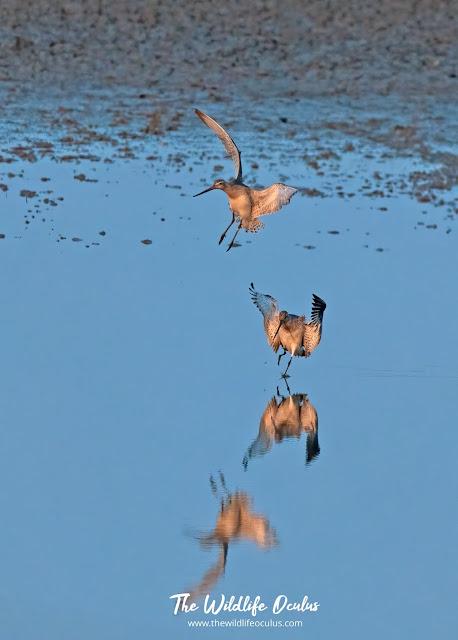Spring migrants drop in at Goldcliff Lagoons
 |
| Yellow Wagtail |
Spring passage is really underway now and Goldcliff Lagoons is having its fair share of migrating birds dropping into the reserve.
Most are only stopping for a short period to rest, fuel up, and then continue their journey which is usually then in a Northerly and Easterly direction. Its a fabulous time to visit the reserve as you never know what is going to turn up.
Adding a nice splash of colour to the reserve are the Yellow Wagtails. These lemon coloured passerines have been arriving at Goldcliff over the last month or so from as far away as North Africa and some even further as they are known to fly across the Sahara Desert. Yellow Wagtails breed in the UK usually in mixed farmland. Due to changes in crop management their population has taken a big hit over recent decades so they are not as common as they previously were. I cannot recall ever seeing them in farmland in the Welsh countryside.
During my visit today there was a very accomodating Yellow Wagtail feeding on the sea wall and occasionally it perched up on the Willow screen on the way down to the Avocet ( Seawall) hide.
 |
| Yellow Wagtail on the electric fence |
The sunshine has been bringing out lots of flying midges and they have been providing a real banquet for any insect eating birds.
Wheatears have been seen frequently on the seawall. Another long distance migrant from far away Africa and several have been putting on quite a show to pose for photographers.
 |
| Wheatear |
Wheatears are members of the chat family and also breed on the UK. Locally there are some great hot spots in the Gwent Uplands to find them such as the Blorenge and Pwl Du. The birds at Goldcliff I am sure are feeding up after their epic journeys and will probably head to the mountains to breed, although they may find they are a little late when they eventually reach their breeding territories.
Today I got my first sighting of the year of a Swift - well actually at least five or more. They came screaming in over the seawall and entertained several of us birders who delighted at the aerobatic antics.
 |
| Swift |
A surprise visitor to the seawall were two Whimbrel. These birds are most certainly on passage. A Peregrine Falcon at high tide was causing chaos out on the Saltmarsh ( and later on the reserve) and put up lots of birds. The Whimbrel seemed to be looking somewhere safe to roost and dropped on to the sea wall. A few of these waders breed in Scotland but most breed in Iceland, Scandanavia and Russia.
 |
| Whimbrel |
 |
| Whimbrel takes off from the wall |
Elsewhere on the reserve there were other migrants. A flock of Black Tailed Godwits remains at large on the reserve. It varies in numbers sometimes 50 to 100 birds and on other occasions three hundred or more birds. The Black Tails are in various degrees of moult and should be heading North to Iceland over the next month.
 |
| Black Tailed Godwits and Ruff |
Throughout the week a number of Ruff have also been sighted. I saw two today. One of them being quite white coloured and captured lower right in the picture above. Ruff are also migratory and these birds should be travelling to Scandinavia where they will start their "leks" and the males turn incredible colours with very ostentatious feather ruffs.
Over the last week the Severn Estuary has been alive with reports of Black Tailed Godwits. These are relatives of the Black Tailed Godwits and can be a challenge to identify for the uninitiated.
On Monks Lagoon two Bar-Tailed Godwits dropped from the sky just after dawn. They were not displaying full breeding plumage to any major extent but they did show well in front of the Redshank platform.
They took flight for a short time and their barred tails to could be clearly seen.
 |
| Bar-Tailed Godwits |
 |
| Bar-tailed Godwits drop from the sky |
 |
| Bar-tailed Godwits |
I always think of May as the Dunlin season as at this time of year historically the reserve starts to get an influx of these little waders. They too gather in order to migrate to Greenland and Iceland. Many are now starting to turn into breeding plumage. The lagoons and the estuary offer them a place to feed up and build their fat reserves up for the long flight North.
 |
| Dunlin |
I did not get an opportunity today to study a flock close up and it was bit fo a shame as I was hoping to get a chance to spot a Little Stint or Curlew Sandpiper ( also Spring Passage birds) moving through with other migratory wader flocks.
So there's a brief taste of some of the migratory birds moving through Goldcliff Lagoons at the moment.
Also in the news -
There was a Spoonbill at the reserve on Thursday.
A Short Eared Owl was spotted today flying over the reserve by a sharp eyed birder.
Great White Egrets continue to turn up even now and again.
Lots of warblers are around with several sightings of Lesser White Throats showing well.
The Spotted Redshank was not seen today but who knows it may continue be on the reserve.
Look out for Little Stints and Curlew Sandpipers.
It was good to catch up with a number of my birding friends today. You know who you are ;)


I don’t know just when I think you’ve written your best blog you top it with a new one, superb photos and information.
ReplyDelete